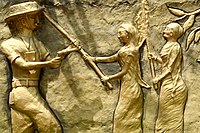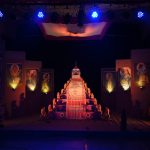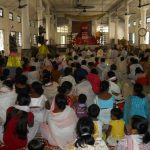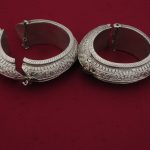Assam has always contributed in different manners to the socio-cultural and political life of the Indian nation, but all these contributions have most often remained unobserved, unnoticed by the national intelligentsia. It is the same with the freedom movement also. Assam had her due share in the freedom movement, where the country fought to a man in order to oust the two-century old British rule from the country. In fact Assam acted as the prime mover in some respect. One such important episode in the annals of freedom movement, where Assam acted as the prime mover, was the uprising in the Phulaguri area of middle Assam in October 1861 AD. It was the first ever peasant movement in the context of Indian freedom movement, which took place much before the Champaran movement took place under the leadership of Mahatma Gandhi. The Bengal farmers had revolted in the previous year, that is 1860 AD. But their ire was against the indigo planters, not against the British administration. So the Phulaguri uprising was a historic event. It was also the first ever non-cooperation movement of Indian freedom movement because the farmers of Phulaguri region had stopped payment of taxes to the British administration and thus openly defied the rulers. This had not happened anywhere in India before Phulaguri.
The immediate cause of the Phulaguri uprising of 1861 AD was the exorbitant taxes imposed by the British administration on the farmers of Assam. The British administration always acted in the interests of the British tea planters, not the common masses. These tea planters had been suffering from dearth of labourers. They had to bring labourers from other states at high costs. Moreover a large number of such labourers died of unhygienic conditions in the tea estates as malaria was rampant in those areas. So the tea planters thought that it would be better to engage the local people as labourers in their estates. But the indigenous Assamese people were always independent minded. Even the erstwhile Ahom kings could not uproot a farmer from the latter’s homestead as the right of the farmer on his land was considered to be supreme.
The land in the Brahmaputra valley being very fertile, the farmers did not need to look for extra vocation too. So none of them took employment with the British tea planters. These tea planters therefore decided to pauperise the local farmers of Assam by increasing the incidence of taxes so that they take up employment in the tea estates. The tea planters placed their design with their brethren in the administration, who readily co-operated in the conspiracy and enhanced the tax rates on the indigenous people. The enhanced tax rates were like these in 1852-53 AD : Tax on cultivable land : 1 rupee and 6 annas per Pura Tax on other land : 1 rupee per Pura Tax on lakheraj rupeet land : 10 annas per Pura Tax on other rupeet land : 8 annas per Pura Tax on each spade : 1 rupee and 8 annas Tax on each fisherman : 5 rupees Such a tax structure was not in keeping with the income level of the people as well as the economic situation of that time. It can be proved by a simple comparison. The prevailing price of cultivable land was 1 rupee and 6 annas per Pura at that time. Ironically this was also the annual tax rate imposed by the British regime. Thus the taxation rate was equal to the value of the asset itself, whereas the taxation rate should have been only a fraction of the productive capacity of the land. Clearly the idea of the oppressive taxation system was to pauperize the people at large. The government were really fleeching the people. They had even imposed tax on each plough in 1833-34 AD. This tax was at the rate of 3 rupees on the first plough and 2 rupees on the second plough. Every able bodied man had to pay tax in that system. But it was more than impossible and it had to be withdrawn in 1850-51 AD.
The oppressive regime of the British had dissatisfied the common people as well as the erstwhile ethnic rulers of the region. Both came together and started planning to overthrow the British regime. It was surmised that the British could be easily overthrown as their military strength was numerically very limited. There were only 25 sepoys in Nagaon at that time. There were some others at Guwahati, Tezpur, Sibsagar and Rangpur. But people thought that their numerical strength would give them an edge over the British sepoys. A British loyalist turned revolutionary, Maniram Dewan used to pass through the valleys of Kalang, Kapili, and Kiling rivers. He would enthuse the poeple of this region to fight against the British. Regular armed training started in the paddy fields of the interior areas. People started equipping themselves with traditional arms like spears, bows etc. A blacksmith named Bhivi Kumar of Molankata was given the task of manufacturing these traditional weapons. Laxman Singh Deka of Katahguri was made the General of this make-shift indigenous army. Most of the members of this army belonged to the Tiwa and Karbi tribes.
These activities started from 1855 AD and would have culminated in an armed uprising. But the capture and execution of Maniram Dewan dampened the spirit of the people and there came a lull in the movement. The simmering anger of the people was aroused again when the British government increased the taxes again in 1861 AD. The government objective was to double the tax collection. This time they imposed taxes even on the forest products made from bamboo, cane, wood etc. Moreover income tax was introduced for the first time. There were also plans to impose taxes on the cultivation of betel nut trees and betel leaf creepers, it was gathered. The British government had been trying to tap all the possible sources of revenue in order to make up for their deficit in budget since the sepoy mutiny. But all these taxes were unheard of before. It made the living unbearable for the farmers as they had already been suffering from heavy taxation. Simultaneously the poppy cultivation was also banned by the British. While it was a good step in apparent look, it was actually done with an aim to take up the trading in opium themselves. Moreover the British themselves had introduced opium among the indigenous people as they wanted to make the people idle and also earn profits by trading in opium. The British first developed the addiction for opium among the native people and then they reaped the benefit by trading in this harmful drug. They priced it at four annas per tola or ten grams. It brought them enormous revenue as majority of the population had already become addicted to this drug. Additionally it also helped them in maintaining political stability as people became lethargic by consuming opium. But that was not to be in the Raha-Phulaguri region belonging to the Nagaon district of Assam.
The people of Raha-Phulaguri region had not only not become lethargic, they were even imbued with the indomitable spirit of nationalism with a do or die spirit. Had Maniram Dewan and his accomplices not been captured and executed by the British, there would have been an armed rebellion in this region against the British during the period of Sepoy Mutiny itself. All important personalities of the region including Rahial Barua had alligned themselves with the cause. Several of them like Krishna Kanta Goswami and Safiun Nessa of Nagaon town were banished to the Andaman island for their involvement in the conspiracy against the British. Naturally the cause took a beating, albeit temporarily. But the ire of the people were aroused again and that too very strongly with the arrival of a British officer named Lt Herbert Sconce. He joined as Deputy Commissioner of Nagaon district in 1858 AD. He humiliated people at the fall of a hat and often imprisoned people for even small matters. He even desecrated religious places of worship. Once he even sat on the altar of the Namghar, the traditional worshipping place of the followers of Eka Sarana Nama Dharma propounded by Srimanta Sankaradeva, the fifteenth century Vaishnavite preceptor. This happened when Herbert visited Phulaguri and entered the Garmur Satra. He also had his shoes on when he entered that place of worship. Such actions made the blood of people boil in anger.
Eventually the people decided to register their protest and dissatisfaction. About one thousand farmers from the Phulaguri region gathered at the court premises of Deputy Commissioner of Nagaon district on September 17, 1861 AD. They intended to protest against the hefty increase in taxes. They wanted to say that there should not be taxes on betel nut trees, betel leaf creepers, bamboo trees etc. But Herbert did not give any importance to the assembly and did not give them audience. According to the official version, some members of the protesting farmers entered Deputy Commissioner’s chamber without his permission. Herbert fined these farmers. Not only that, he even got them beaten up and then detained for the rest of the day. Even then the people decided to petition once more. This time a limited number of persons went to meet Herbert on October 9, 1861 AD. They handed over a petition asking for relief to the people from the exorbitant taxes. There were several distinguished men in the delegation including the headman of the Phulaguri village. But Herbert rejected this polite and humble petition too. This left the people with the Hobson’s choice of embarking on non-cooperation with the British administration. They decided not to pay any tax to the British administration any more. Thus the first ever non-cooperation movement in the annals of India’s freedom movement was launched in the Phulaguri region of Assam in October, 1861 AD.
The entire decision making in this movement was done by the farmers themselves as the erstwhile middle class leaders had already been removed by the British administration by way of execution and banishment. Eventually when the people would come out openly, that too would be an all peasant affair. Thus it was out and out a peasant movement, the first in the annals of India’s freedom movement. The people of Phulaguri region convened a five day convention in order to mobilise all round support for their non-cooperation movement. The convention was scheduled from October 15 at Phulaguri village. It was called Raij Mel or assembly of people. It was planned as a representative type convention where public representatives from different villages would participate. So delegates were selected by the respective villagers. It was thus a democratic venture.
Since the village Namghars of Assam had always acted as a democratic platform for the villagers as taught by the saint reformer Srimanta Sankaradeva, the organisers did not have to initiate any new concept or make any extra effort. Srimanta Sankaradeva had designed the Namghar as an all-round institution covering socio-cultural-spiritual affairs of the people. People now extended it to political affairs too. Even the main convention at Phulaguri took place in a Namghar only. As many as 600 people gathered in the Namghar of Phulaguri on October 16. Herbert sent Haladhar Barua, the officer-in-charge of Nagaon Sadar Police Station to take stock of the situation. Haladhar ordered the gathering in the Namghar to disperse, but the crowd disobeyed him. Thereupon Haladhar, who had only ten Barkandaz with him alongwith one Jamadar, made a hasty retreat. Unlike the sepoys, who carried fire-arms, Barkandaz carried only spears. Haladhar consulted the matter with Herbert and returned again on the next day, October 17. This time he arrested the leading persons. Even then an assembly of about 350 persons remained there in the Namghar. Clearly the people were not ready to bow down before the insensitive British administration. It was conveyed to the people that Herbert himself would visit Phulaguri the next day.
According to the official version, the protesters had overpowered Haladhar and got the arrested persons released. However Herbert changed his mind on the next day, that is October 18. Instead, he sent Lt Singer, a Junior Assistant Commissioner. Singer was deputed by Herbert to control the situation, not to hear the grievances of the people. Singer was accompanied by Haladhar, the officer-in-charge of the Nagaon jail, a clerk named Anadar and six Barkandaz. They arrived at Phulaguri in the forenoon to find that there was no assembly in the Namghar. Singer decided to wait near the Namghar. He called for more force. Five Barkandaz and six sepoys arrived before long. Around noon, people started gathering in a nearby spot outside the Namghar. All the people carried their traditional sticks.
The Assamese people used to carry a bamboo stick in those days in order to ward off any animal or clear any object on the way as the roads were not so well defined and it was also full of jungles. Singer got very angry by seeing the people equipped with sticks. He did not know about the local custom of carrying the sticks. He asked people to drop their sticks as well as to disperse from there. But no one moved. Then Singer asked Haladhar to take away the sticks. When Haladhar started to take away the sticks, people became very agitated and they got up from squatting position. Then some one from the crowd attacked Haladhar with a spear. He was badly injured. Thereafter Singer started reproaching the agitators and he proceeded towards the crowd in spite of a warning by Haladhar not to do so. Singer was trying to take away the sticks from the people, when one Moira Singh hit him on the head, which was followed by other people. In no time Singer succumbed to the mob assault. His body was dragged by the people and thrown into the nearby Kalang river.
In the mean time the crowd had swelled to about 3,000. They killed three sepoys too. The other sepopys and Barkandaz fled to the Nagaon town. The agitationists became very excited over the turn of the events. One group from among them proceeded towards Raha and they attacked the police station there. Golap Singh, the officer-in-charge of the Raha police station met with the same fate as that of Singer. Another group of the agitationists went to Kachalukhowa and they attacked the government magazine house located there. After that, they proceeded in the direction of the government treasury with an intention to plunder it, but they were obstructed by some sepoys on the way. Suwabar Lalung, hailing from Babara-ati succumbed to the police firing. Thereupon the agitationists retreated. As there had been only 25 sepoys in Nagaon at that time, 50 more sepoys were brought from Tezpur on October 19. Captain Campbell was in the command of this re-inforcement. He came to Phulaguri with his command. The agitationists also gathered again in order to review the situation. Campbell surrounded those unarmed people and started firing upon them, leading to the instant death of 39 persons and serios injury to hundreds. However according to the official version, nineteen persons died. The injured ones lay lying on the ground in pools of blood without any help, not even a drop of water. Only 66 persons remained capable of standing. All of them were taken on feet to Nagaon and put in a temporary jail.
On October 23, General Henry Hopkinson, the Commissioner of Assam arrived at Phulaguri with 100 sepoys and started an all-out torture regime in the Raha-Phulaguri region. Not only the male members, even the female members were not spared. The sepoys violated the modesty of the women and touched their private parts. More than 400 persons were rounded up, although the official figure put it at 41 only. They were kept in an enclosure at Phulaguri alongwith the dead bodies of the 39 persons killed in the firing of October 19. Those bodies were rotting and emitting foul smell, making it impossible even for the British sepoys to guard the detainees. It was only much later that the relatives of the dead were allowed to take the bodies away and cremate them. Disturbed over the inhuman atrocities on the fellow people, the leaders of the uprising surrendered before the administration. They were Laxman Singh Deka Senapati, Rangbar Deka and Changbar Lalung. They confessed to killing Lt Singer. All of them were hanged in the Nagaon jail. Some other leaders were banished to the Andaman island. They were Bahoo Kaibarta, Banamali Kaibarta, Rup Singh Lalung, Sib Singh Lalung, Hebera Lalung, Nar Singh Lalung and Katyia Lalung. Many government functionaries were changed as the erstwhile functionaries were suspected of alligning with the rebel farmers. And thus a peasant movement was suppressed.
The Phulaguri uprising was suppressed ruthlessly. But it left an indelible mark on the history of Assam. The concept of Raij Mel became popular all over the Brahmaputra valley in spite of all types of disinformation campaign by the British administration. According to the official version, the uprising was a protest by the opium eaters who were disenchanted by the ban on opium cultivation. The number of deaths also was shown as less than the actual figure. In spite of all these disinformation, peasant movement became the order of the day during the succeeding decades. Eventually the British administration were compelled to review the oppressive tax structure. Certainly it was a victory of the people. The sacrifice of the Phulaguri peasants did not go in vain. The participants of this uprising also succeeded in upholding the dignity of the common masses of Assam. Another notable feature of the Phulaguri uprising was the absence of any national leader in the scene. Even any state level leader was also not present in that region during the entire course of the uprising. Not only that, the district level prominent persons also were kept away by the British as all of them had been arrested immediately after the Sepoy Mutiny. This vacuum of leadership did not cause any problem in the progress of the uprising. But that was perhaps a cause of the whimsical assault by some of the peasants on Lt Singer. It was certainly uncalled for. It happened as there was no one to control the assembly of people on that fateful day. But such things happen just as it happened at Chauri Chaura during the later period of freedom movement.




